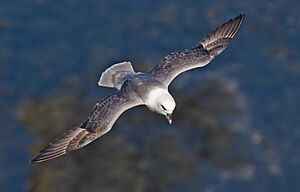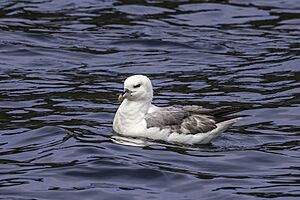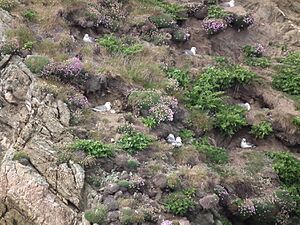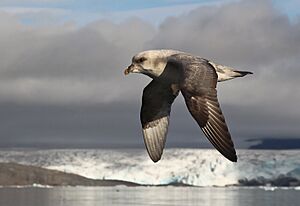Northern fulmar facts for kids
Quick facts for kids Northern fulmar |
|
|---|---|
 |
|
| Conservation status | |
| Scientific classification | |
| Genus: |
Fulmarus
|
| Species: |
glacialis
|
| Subspecies | |
|
Fulmarus glacialis glacialis |
|
 |
|
| Range of F. glacialis Breeding range Wintering range |
|
| Synonyms | |
|
Procellaria glacialis Linnaeus, 1761 |
|
The northern fulmar (Fulmarus glacialis), also called the fulmar or Arctic fulmar, is a common seabird. You can find it mostly in the cold northern parts of the North Atlantic and North Pacific oceans. One bird was even seen far south near New Zealand.
Fulmars come in two main colors. Some are light, with a white head and body and gray wings and tail. Others are dark, being gray all over. Even though they look a bit like gulls, fulmars are actually part of the Procellariidae family. This family includes other sea birds like petrels and shearwaters.
The northern fulmar and its close relative, the southern fulmar, are the only living members of their group, called Fulmarus. Fulmars belong to a larger group of birds called Procellariiformes. All birds in this group share some special features. They have unique nose tubes on their upper beak called naricorns. Unlike albatrosses, whose nostrils are on the sides of their beaks, fulmars have them on top.
Their beaks are also special because they are made of several strong plates. One of these plates forms the hooked tip of their upper beak. Fulmars can also make a special stomach oil. This oil can be sprayed out of their mouths to protect themselves from predators. It's also a rich food source for their chicks and for adults during long flights. This oil can stick to the feathers of other birds, which can be dangerous for them. Fulmars also have a salt gland above their nose. This gland helps them get rid of extra salt from their bodies, since they drink a lot of ocean water. It releases a salty liquid from their nose.
The northern fulmar was first described by Carl Linnaeus in 1761. He found a specimen from the Arctic Circle on Spitsbergen. A mountain in Greenland, Mallemuk Mountain, is named after this bird.
Contents
How Scientists Classify Fulmars
Scientists formally described the northern fulmar in 1761. This was done by the Swedish naturalist Carl Linnaeus in his book Fauna Svecica. He first put it in the same group as other petrels, calling it Procellaria glacialis. Linnaeus based his description on a bird called "Mallemucke." This bird had been described and drawn in 1675 by a German naturalist named Friderich Martens.
Today, the northern fulmar is placed in its own group, Fulmarus. This name was given in 1826 by the English naturalist James Stephens. The name Fulmar comes from an old Norse word, Fúlmár, which means "foul-mew" or "foul-gull." This is because the birds often spit out a foul-smelling oil. The second part of its scientific name, glacialis, is Latin for "icy," referring to its cold habitat.
There are three types of northern fulmars, called subspecies:
- F. g. glacialis (Linnaeus, 1761) – This type lives and breeds in the high Arctic parts of the North Atlantic.
- F. g. auduboni Bonaparte, 1857 – This type breeds in the lower Arctic and colder forest regions of the North Atlantic.
- F. g. rodgersii Cassin, 1862 – This type breeds along the coast of eastern Siberia and the Alaskan Peninsula.
What Northern Fulmars Look Like

The northern fulmar has a wingspan of about 102 to 112 centimeters (40 to 44 inches). It is about 46 centimeters (18 inches) long. These birds usually weigh between 450 and 1000 grams (1 to 2.2 pounds).
This bird is gray and white. It has a pale yellow, thick beak and bluish legs. However, there are two main color types: a light one and a dark, or "blue," one. In the Pacific Ocean, there is also a mix of these two colors. Only the dark type has dark edges on the underside of its wings. All types have pale inner feathers on the top of their wings. The Pacific type has a darker tail than the Atlantic type.
Like other petrels, fulmars don't walk very well. But they are very strong fliers. Their wings move stiffly, which is different from how gulls fly. They look like they have thick necks compared to gulls and have short, stubby beaks. Northern fulmars can live a long time, often up to 31 years.
The total number of adult northern fulmars is estimated to be between 15 million and 30 million. Their population is generally increasing.
Fulmar Behavior
Feeding Habits
Northern fulmars eat many different things. They feed on shrimp, fish, squid, plankton, and jellyfish. They also eat dead animals and leftover food. When they catch fish, they can dive several feet deep to get their prey.
Life Cycle and Reproduction
Northern fulmars start having chicks when they are between six and twelve years old. They stay with the same partner for life and return to the same nesting spot every year. The breeding season begins in May. During this time, adult fulmars usually stay within 500 kilometers (310 miles) of their nesting colony.
Their nest is a simple hollow on a grassy ledge or a shallow dish of plants on the ground. Both parents help build the nest. The female lays one white egg, about 74 by 51 millimeters (2.9 by 2 inches). Both parents take turns sitting on the egg for 50 to 54 days. The chick is born helpless and is kept warm by its parents for two weeks. It is ready to fly after 70 to 75 days. Both parents also help feed the chick. During this time, the parents are active mostly at night, even on bright nights.
Social Interactions
The male fulmar performs a special dance to attract a female. The female rests on a ledge, and the male lands with his beak open and head tilted back. He then waves his head from side to side and up and down while making calls.
When they eat, fulmars make grunting and chuckling sounds. During the breeding season, they make guttural, throaty calls.
Conservation Status
Scientists estimate there are between 15 million and 30 million adult northern fulmars. They live across a huge area of about 28.4 million square kilometers (11 million square miles). Their population in North America is growing. Because of this, the IUCN lists them as a species of "Least Concern".
The number of fulmars grew a lot in the last century. This was partly because they could eat fish scraps from fishing boats. However, their numbers might go down in the future if there's less food from this source or due to climate change. The population has grown especially fast in the British Isles.
Human Impact on Fulmars
Northern fulmars are very important for studying marine debris (trash in the ocean). This is because they are common and found in many places. A study from 2008 to 2013 looked at 143 northern fulmars. It found that almost 90% of them had tiny plastic pieces, called microplastics, in their stomachs. On average, each bird had about 19.5 pieces of plastic.
This amount is higher than in older studies, which might mean there's more plastic in our oceans. However, more research is needed to be sure. Long-term data from the Netherlands shows that fulmars are eating more everyday plastics and less industrial plastics.
Fulmars might eat plastic indirectly. Their diet includes small sea creatures like plankton, which have been shown to eat microplastics. This means plastic can move up the food chain. If fulmars eat plastic, it could also affect the animals that eat fulmars. As more plastic gets into freshwater, there might be even more microplastics in seabirds' stomachs.





